Mail.Ru Group 20 years: Checkpoint code and technology

By the standards of the Internet, 20 years is a long time, but it’s too early to sum up (this is only the first 20 years!). Today we will not spin the flywheel stories about our formation. Too much has happened, and for us every small, by the standards of a casual observer, turn is a big event. Here we need a book, not a habrapost.
The story will go about what has generally happened to the Network over these decades. We changed together, influenced each other. Ultimately, the MRG path mirrored all the important milestones in the evolution of the world wide web. We have not yet figured out where to introduce the blockchain.
')
In honor of the 20th anniversary, we will see in retrospect how technology has changed. We will concentrate on a warm plaid, plunge into the blue glow of CRT monitors, reveal grandfather lootbox and consider the artifacts of the past.
1998: Mail

Today Mail.Ru Group is the largest holding in Russia by daily mobile audience, but it all began literally from the “garage”. In 1998, the team of St. Petersburg programmers created the mail service Mail.Ru and laid it out on the Internet for testing, which was not the most attractive for Russian business in 1998.
The history of e-mail has more than one decade. The first letter on the network, consisting, according to various sources, of the phrase “Test123” or “QWERTYUIOP”, was sent in 1971 by the programmer of the ARPANET project Ray Tomlinson. We owe him the widespread use of "dogs."
The Mail.Ru Mail logo and the indispensable companion of any letter - @ - is the answer to the question where the message should be sent. Initially, the addresses had the form username @ hostname, but together with the development of the domain name system, the addresses were expanded to username@host.domain.
By 1976, 75% of all ARPANET traffic accounted for email. The new service turned out to be so useful that ideas began to emerge on how to send an e-mail outside the internal network.
Until the 90s, experts predicted that e-mail will soon be replaced by other services. For example, a fax machine that could transmit images, while only text was available in the mail.
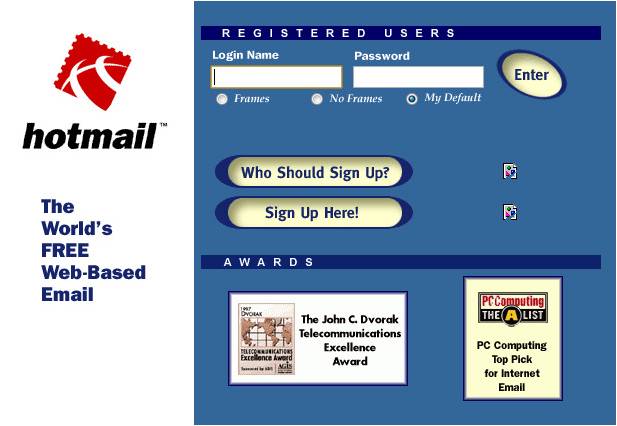
In 1996, Hotmail launched the first free web-based email service. He drew attention to Microsoft. In 1997, the project was bought for $ 400 or $ 500 million (data differ).
The big deal did not go unnoticed in the emerging market of Internet technologies. The prototype Mail.Ru Mail was developed by Alexei Krivenkov for internal tasks of the company DataArt Enterprises Incorporated in 1997. However, the incredible success of Hotmail pushed Krivenkov and his colleague from the St. Petersburg office of Dmitry Andrianov to start his own project. The main owner of DataArt Eugene Goland supported the initiative - the team bought the mail.ru domain and launched the service in test mode.
The project quickly gained popularity and for several months became the leader in the number of users. On its basis, the company Port.Ru was created, which took up the development of Internet services. In just two years, every third user of the Runet sent messages via mail to Mail.Ru.
Soon Port.ru, engaged Mail.ru, Rabota.ru, Talk.ru and Autoport, teamed up with NetBridge Services (Molotok.ru, List.ru, Boom.ru). New company called Mail.Ru. And only in 2005, Mail.Ru will become Mail.Ru Group.
2000: content and media projects
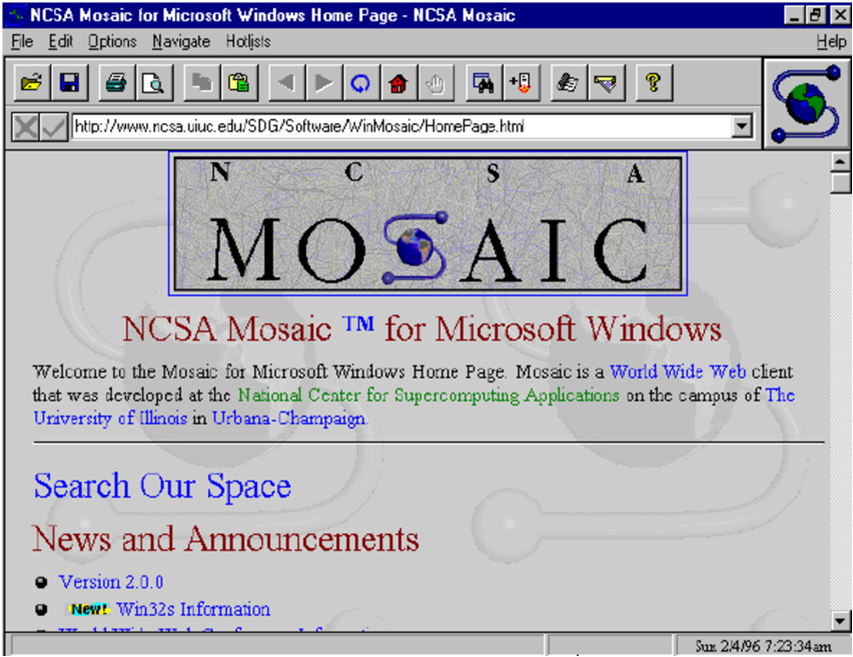
In 1993, the University of Florida School of Journalism launched the first online media shortly after the release of the Mosaic beta, the first Windows-based web browser with a graphical interface.
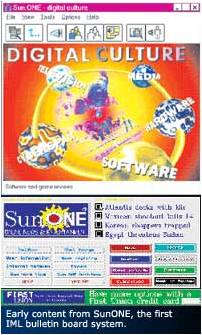
The development of the web led to the creation of an electronic bulletin board - the forerunner of all content projects of the future. Sun.ONE posters of the project received on the site all that they could find in the classic newspaper: news, sports and advertising. One of the world's first content projects was a new stage in global journalism.
In 1999, Netscape began using RSS technology to populate its Netcenter portal. After some time, this technology was used to broadcast content on many news sites - BBC, CNET, CNN, Disney, Forbes, Wired, Red Herring, Slashdot, ZDNet, and many others. In the same year, The Guardian began a minute-long coverage of events - life blogging.
The ability to receive news in real time spurred the development of online journalism, and on September 11, 2001, it changed the media forever and made millions of viewers follow the events in New York and on television and online, which led to an unprecedented increase in traffic on many world resources.
News.mail.ru, while news.list.ru, was already one of the largest news resources of the Russian Internet. But he was not supposed to have a separate server, he worked on one Pentium 3 with several other projects.
On September 11, “News” provided the service with a tenfold load, constantly optimizing the work of the site. First, the main Mail.Ru page became static, then the pages with key news, then the Poster was turned off to save resources.
17 years have passed since then, and the life of the news resources themselves has changed a lot. For example, the project Hi-Tech Mail.Ru once sat in a business center on the ground floor, next to the dining room. They, like many well-known content-projects of the Runet, began with tiny rooms, where barely enough space for several tables of employees. They did not even have a special corner for reviews of gadgets, sometimes they had to test right on the floor. Now Hi-Tech Mail.Ru is in the Top 10 of the largest IT sites in the world, overtaking Engadget, Techcrunch, Wired and many other foreign projects.
2003: instant messengers
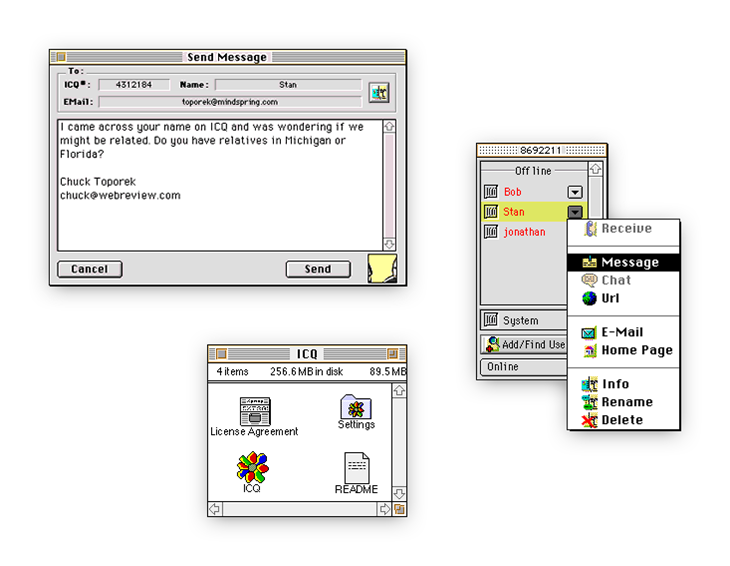
ICQ is the famous free instant messenger for mobile and desktop platforms with voice and video support. The first version of ICQ appeared on November 15, 1996, and at that time could only provide text messaging between users.
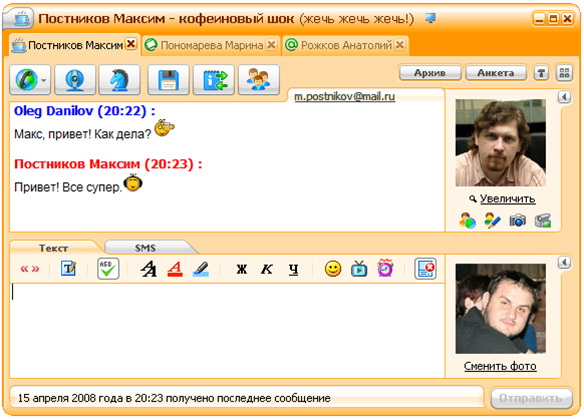
( c )
Mail.Ru Group acquired ICQ in 2010, they want at that time the company already had its own messenger - Mail.Ru Agent, developed since 2003. Contrary to common practice, they did not close the competing product, projects began to develop in parallel, and in January 2011 the 7th version of ICQ was released, in which integration with Mail.Ru Mail, Facebook, Twitter, Gmail, Youtube and Flickr appeared.
ICQ is an international brand that is well known abroad. By that time, the Agent was already very popular in the CIS, and there was no point in forcibly transferring users to another platform. However, it is quite possible that in the future the messengers will be merged.
Currently, ICQ has more than 11 million active users, a modern design, all relevant features of messengers are implemented, there is integration with neural networks for photo processing, as well as face detection and three-dimensional interactive masks.
At the same time, the group of companies has always supported healthy competition between projects. Mobile applications of social networks can also be attributed to projects of rapid communication between users. On the basis of "OK Messages" (Odnoklassniki project) in May 2017 a cross-platform TamTam messenger appeared. In a way, this reflects the global trend - there are many popular instant messengers in the world and there is no project that has prevailed.
2006: social networks

The main feature of the Runet projects is not how they appeared (all successful stories are remarkably similar and only the failures are original). It is surprising that they appeared and survived in the face of strong international competition. This rule applies to our social networks. Very few countries in the world where Facebook, Twiiter, Instagram failed to defeat national social networks.
VKontakte, Odnoklassniki and My World develop in mutual synergy, although it is imperceptible to an outsider. So, in 2011, the My World Network development and support team (which absorbed both photo hosting Photos Mail.Ru and video hosting Mail.Ru video) got into one business unit along with OK and started developing a large joint video partition.
Combining competing social networks at some basic infrastructural level, as well as sharing competencies, knowledge and technology, was difficult to imagine at the international level until 2012, when Facebook bought Instagram. Today, this is the norm on which all large companies are bidding, wishing not to lose a new audience and attract the most demanding users from the generation to the 18th.
Users can refuse a product only because it is “old”, “unpopular” or “too popular with parents”. That is why now the social network is first of all an application for a smartphone. Every day tens of millions of people use VKontakte applications for iOS and Android. According to the Mediascope study, the VK mobile application is the most popular in Russia. It is used by 42% of the population.
The absolute leader in time spent on the network, among the thematic groups are social networks - 22% of the total time in the desktop and 24% in the mobile segment. 52% of Russians log in at least one of the social networks every day.
2011: educational projects
November 18, 2011 at MSTU. N.E. Bauman held a speech by the Director General (at that time) and co-founder of the Mail.Ru Group, Dmitry Grishin, who announced the launch of the Technopark project. The goal of the project has not changed to this day: we teach undergraduate and graduate students for free in order to create a personnel reserve for the IT industry.
Technopark gave students the opportunity to learn from the Mail.Ru Group employees, try their hand at real projects and solve real problems. The launch of the educational direction of the company's development was successful, and today, in seven leading leading Russian universities, there are programs for additional IT courses for students: Technopark in Moscow State Technical University. N. E. Bauman, Technosphere (VMK MSU), Technotrek (MIPT), Technopolis (SPbPU), Technoat (NRNU MEPI), Igrosfera.Penza (PGU), Igrosfera.Voronezh (VSU).
In addition, since 2016 Mail.Ru Group has owned GeekBrains, an educational portal for marketing, design and programming training. As a result, participants in educational projects of the company in a half year became a million more. And this number continues to grow every year - all new people who want to gain knowledge are connected to ordinary students, and today the audience of GeekBrains is more than 3 million people.
Today Mail.Ru Group conducts full-time study programs in universities, conducts educational meetings and conferences in the office, organizes competitions for schoolchildren, publishes lectures on Habré and the Tehnostrim YouTube channel, organizes championships for developers and not only.
2011: DBMS

The first logo of our database
The first article about Tarantool appeared in 2011, and it already talked about version 1.3. Although the first issue took place back in 2008, the project was in the beta stage for a long time and was being finalized before being used on the Mail.Ru portal.
Tarantool is an open source database management system. It combines the speed inherent in caching systems and the reliability of industrial solutions. DBMS is available to all users, both for commercial organizations and non-profit.
In addition, Tarantool offers an IoT platform developed for the industrial Internet of things. The new product will allow data to be collected from millions of sensors located on production sites, vehicles, agricultural fields, and sent to data centers for online analytics.
Open source project is not typical for a corporation. We were guided by several statements shared by many open source advocates. First of all, open source contributes to the formation of a community that writes code, check source codes for errors, creates its own tools. In the case of Tarantool, openness significantly contributed to the growth of popularity.
2013: Cloud
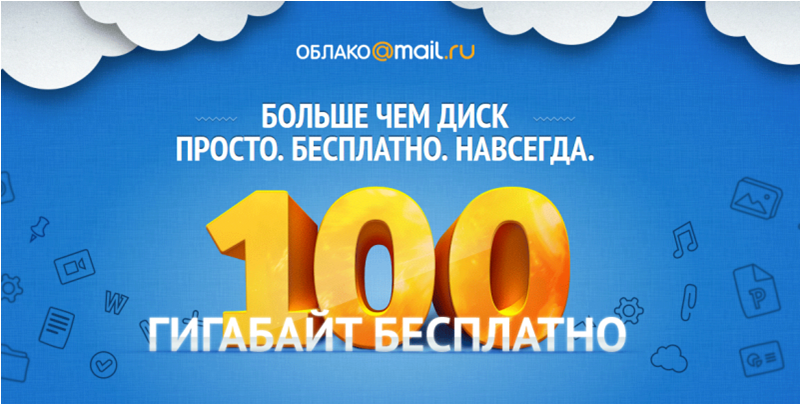
Remember this promotion?
The open Mail.Ru Cloud for users appeared in 2013, but the very concept of cloud computing dates back to the early 1960s. It is believed that cloud computing was proposed by theoretical theorist Joseph Karl Robnett Liklider when during the work on ARPANET it became necessary to constantly exchange data between project participants.
In 1983, CompuServe, the first major provider in the US, offered consumers a small amount of remote disk space that was used to store any downloaded files. The era of cloud archives began, although at that time they were not yet called that.
In 1994, AT & T launched the PersonaLink Services online personal and business communication platform, whose users also gained access to the cloud-based archive. It should be noted that the term "cloud computing" appeared only in 1996, when George Favaloro used it in the Compaq business plan. A scanned version of this plan has been preserved to this day.
Most users learned about this technology only in 2006, when Google and Amazon began using the term “cloud computing” to describe a new paradigm in which, in addition to PCs, users are increasingly turning to computing power and files via the Internet.
Against this background, Dell’s attempt to register the term “cloud computing” in 2008 looked funny, especially after in 1997 entrepreneur Sean O'Sullivan did the same.
2014: map service

Our second open source project appeared in 2010 in Minsk under the name MapsWithMe, and became part of the Group in 2014. Now you know these maps for mobile devices under the name MAPS.ME.
The changes followed quickly: we embarked on the development of an ecosystem for tourists, achieved an increase in the number of users more than doubled, made the service free (to this day), implemented many features for interacting with maps.
Open source - Mail.Ru Group solution. We helped the open project of drawing maps OpenStreetMap, on which MAPS.ME is based, increasing the visibility of this “cartographic Wikipedia” in the information field, and drew additional attention to the interesting activities of cartographers in general.
2016: Foodtech
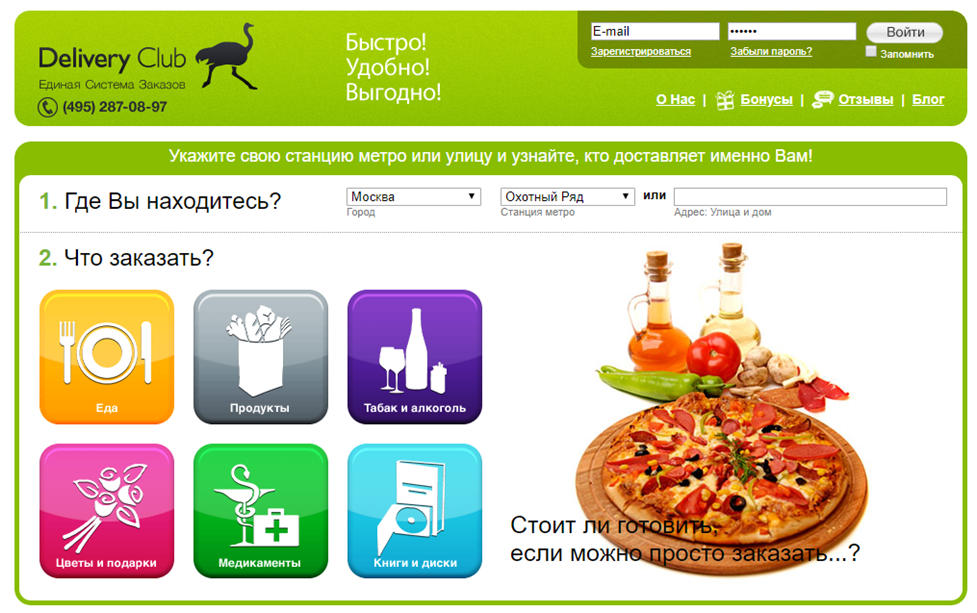
So the page looked 8 years ago ...
In the 90s and 00s, large businesses, then medium and small, discovered online, started standalone blogs and corporate websites, began to receive traffic and customers from a new field of activity.
Then the situation changed to the opposite. Already online business has discovered offline and began to launch products that are not directly related to the code. One of these products for us was food delivery. In November 2016, Mail.Ru Group acquired the Delivery Club. Thanks to the company's capabilities, the number of orders on the platform doubled in a year.
The direction “order online - deliver to the door” existed before, but only in the 10s the level of development of the mobile web allowed organizing a user-friendly environment: you do not need to go to dozens of different resources to make an order, you just need to use one application.
What is not said?
About many things. In November 2013, the company launched the international startup My.com. And then there is Welcome Mail.Ru - the first mass service for good deeds throughout Russia. And many, many other wonderful, significant projects that shape the image of the company and set the direction of its development for the years ahead.
What happened in 20 years? The most important thing is that we have brought closer the future that we could only dream of earlier. The future of the Internet, services, humanity. Projects that in the 90s seemed like distant fiction are today a reality where the border between the virtual world and the offline space becomes as transparent as possible.
Often, the future is represented as the world of flying cars, robots, strong AI, space flights. But if you step back and look impartially at the past 20 years, appreciating all the achievements of civilization "on the other side of the shell of technology," you can again experience enthusiasm and surprise.
In 1998, e-mail seemed to be a revolution, changing the world. Today it is the same routine as a postman 30 years ago. Your smartphone is full of applications that save time, make it easier to achieve goals, which determine the level of comfort in the 21st century. Your job is probably related to the creation of code. And it often happens that your vacation is also a code spinning on distant servers.
This whole world has become possible thanks to people who were not afraid to dream and achieved their goals. Not only in Mail.Ru Group - in thousands of IT-companies around the world. And most importantly, the delight of new achievements has not disappeared anywhere over the years. One can only guess what kind of world the desire to change reality with the code in the next 20 years will bring us.
Source: https://habr.com/ru/post/426441/
All Articles